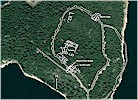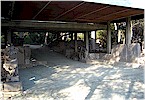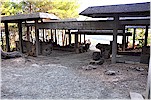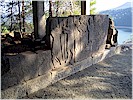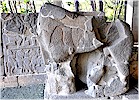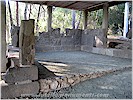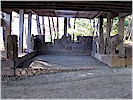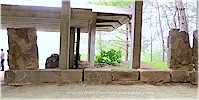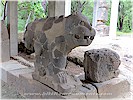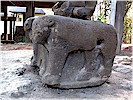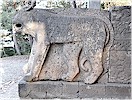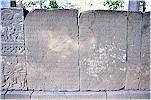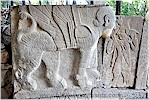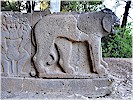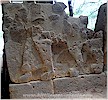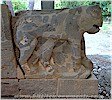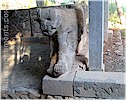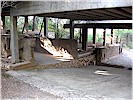Türkçe
Karatepe
The Late Hittite fortress of Karatepe (also named as Aslantaş) is in the province of Osmaniye and in the district of Kadirli. Upon tips from Erol Kuşçu, a local teacher in Saimbeyli, the site was discovered in 1946 by archaeologists Helmut Bossert and Halet Çambel. Excavations between 1947 and 1951 were conducted by a team under Helmut Bossert, and from 1952 on intermittently continued by teams headed by Halet Çambel until 1990s. The fortress and the surrounding area was declared a national park in 1958. After the building of the Aslantaş Dam the site sits on a peninsula within the park. The fort itself has been turned into an open air museum. The site has been added to UNESCO World Heritage Tentative List and the Karatepe inscriptions to UNESCO Memory of the World Register.
The fortress is bordered on the west by the caravan road that leads connects the southern plains to the Central Anatolian plateau and on the east by the Ceyhan River (antique Pyramos) now the Aslantaş dam lake. In the north and south side of the fortress walls, there are two monumental T-shaped gateways flanked by high towers that give access to the citadel. At both gateways an entrance between the two towers leads up to a doorway that used to have double-leafed wooden door which swung on basalt pivot-stones, and behind the doorway there are two chambers on the right and left. At the inner entrance of the south gate, presumably in a sacred area, stood the monumental statue of the Storm-God on its double bull socle. The statue has been restored and set upright in its original position. At both gateways, the walls of the passage ways and the left and right chambers were adorned with sculptures of lions and sphinxes, inscriptions and reliefs, depicting cultural, mythological and daily-life scenes carved on basalt orthostats. A bilingual text in Phoenician and Hieroglyphic Luwian, the longest known texts in these languages, is inscribed on the orthostats and sculptures of each gate, and the same text is repeated in Phoenician on the Storm-God statue. The bilingual text was instrumental in advanced decipherment of the Hieroglyphic Luwian.
The text reveals that the fortress was founded by a person named Azatiwada, who named it after himself as Azatiwadaya. Azatiwada does not bear any titles but he is apparently a subordinate of the king of Adanawa, which is the same as or lies within the Neo-Hittite Kingdom of Hiyawa, also known as Que/Quwe in the Assyrian sources. The text names a king Awariku, whose name is also attested in the Hasanbeyli inscription. His name is also compared with that of Warika the king of Hiyawa/Que, mentioned in the inscriptions of Çineköy, İncirli and Cebelireis, but which of these names refer to the same individuals remains debated. The Karatepe inscriptions probably date to the very last years of the 8th century BCE. The kingdom of Hiyawa/Que was already a vassal of Assyria during that time and at the latest by the reign of the Assyrian king Esharhaddon (680-669 BCE) the area permanently had become an Assyrian province.
Click on the pictures for larger images.
The site

